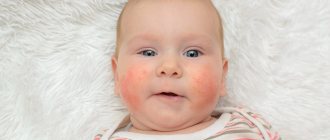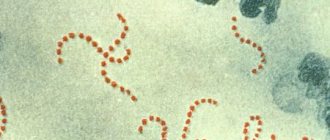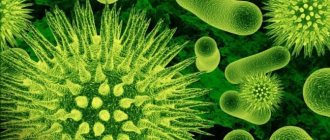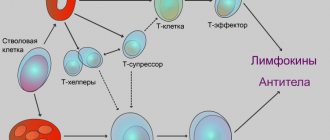Atopic dermatitis is a genetically determined skin disease based on allergic inflammation.
Let's start with the fact that the term atopic dermatitis is relatively new. Although, in fact, the diagnosis of “atopic dermatitis” was included in the international classification in the group of allergic diseases back in 1933, in our country, until 1999, two terms were used to designate this disease: in adults and adolescents - neurodermatitis, in young children groups - diathesis.
The word diathesis from Greek is translated as inclination or predisposition. From this we can conclude that for a long time, domestic pediatricians (there were few allergists in the country at that time) considered allergic damage to a child’s skin in the form of dryness, peeling and weeping, especially on the cheeks, not as a disease, but as a harbinger of more serious, already “real” ones. » allergic diseases such as eczema, allergic rhinitis and bronchial asthma. But why was diathesis not considered an independent disease? I think you yourself know very well that in past times, diathesis tended to disappear around the age of three. It disappears even now, but unfortunately more and more often it does not disappear, but remains with the child for quite a long time, if not for life.
Atopic dermatitis: causes
The first reason is hereditary predisposition. Can be passed on from parents. If both parents of a child had or still have some kind of allergy in childhood, then the likelihood of it developing in the child is very high. But in addition to the hereditary factor, the following play a huge role:
- Nutritional pattern of the expectant mother and newborn baby;
- Home conditions, the quality of drinking water and bathing water, the length of daylight hours, but most importantly - the child’s contact with natural sunlight (light passing through windows and double-glazed windows loses its beneficial properties);
- Prophylactic intake (or “non-administration”) of vitamin D;
- The use of antibiotics by a pregnant or nursing mother, as well as the frequent and not always rational use of antibiotics.
What is atopy
October 17, 2020
Atopy is an abnormal response of the body to common allergens in the environment. Contact with an allergen, which may be food, dust, pet dander, or laundry detergent residue on clothing, stimulates the production of IgE antibodies, which are responsible for the allergic reaction. Atopy is an abnormal autoimmune response to a small amount of a substance that most people consider neutral. Simply put, atopy is a person's excessive tendency to have an allergic reaction. Atopy itself is not a disease, but conditions such as atopic dermatitis, bronchial asthma and allergic rhinitis can result. The production of antibodies to substances that are not dangerous to humans is not neutral for the body. This leads to the formation of inflammatory reactions, which are the cause of the above diseases. People prone to atopy usually have an allergic reaction to a number of different substances, less often to just one allergen. Incidence of atopy. Atopy is diagnosed in 1-3 percent of cases. adults and 10-15 percent. Children. The disproportion between the group of adults and the group of children shows that atopy most often grows out of it or its symptoms become much weaker over time. However, the percentage of people struggling with atopic diseases has been increasing over the decades due to environmental factors. People who live in cities with high levels of pollution are most susceptible to atopy. Types of atopic diseases. Most often, the body's abnormal reaction to contact with an allergen concerns those organs that are in direct contact with the allergen, that is, the skin, respiratory system and gastrointestinal tract. Atopic diseases include: Bronchial asthma - a reaction to a sensitizing allergen occurs in the respiratory tract. The allergen causes bronchospasm and increased reactivity. As a result, the patient experiences coughing attacks, which also occur at night or during certain times of the year when he is exposed to higher concentrations of the allergen, especially the airborne allergen, i.e., pollen season. Atopic urticaria is a skin reaction to an allergen that causes the skin to become red and blistered. It usually goes away on its own, some time after the allergen is eliminated. Atopic conjunctivitis is an inflammation of the conjunctiva, i.e., the delicate membrane that covers the eye and eyelid from the inside with a thin layer. It manifests itself as lacrimation, redness, burning and itching in the eyes and swelling of the eyelids. Atopic rhinitis or sinusitis is an inflammatory process that affects the nasal mucosa, Eustachian tubes and middle ear, and/or sinuses and throat. The patient sneezes, the notorious “nose flies out”, sometimes the nose is stuffy. Genetic predisposition to atopy. Numerous population studies, in particular observations of monogamy and fraternal twins, confirm that the tendency to atopy is hereditary. The mode of its inheritance is complex, there are several genes. The risk that a child will inherit atopy from one parent is approximately 30%. If both parents have atopy, the risk increases to 70%. All atopic diseases involve an abnormal response to an allergen, so people who overreact to allergens usually have multiple atopic diseases. Atopy should be considered more broadly, including in the context of inheriting a tendency to react incorrectly to an allergen. For example, from a parent diagnosed with atopic dermatitis (AD), a child may inherit atopy, which manifests as atopic rhinitis. Prevention of atopy. Many parents would like to protect their children from atopic dermatitis and other atopic diseases, especially if they themselves experienced them in their youth. Although we cannot eliminate the genetic factor that is passed down from generation to generation, we can eliminate other factors that may lead to a tendency to atopy. The main preventive measures in this regard include: breastfeeding for up to 6 months, stopping smoking during pregnancy - smoking during pregnancy has far-reaching consequences, and one of them is the possibility of developing atopic diseases, preventing smog for pregnant women and young children — smog is dangerous for everyone. High concentrations of dust increase allergies, asthma and respiratory problems, which makes it possible to avoid high exposure of a pregnant woman to air allergens (mainly house dust mites) if she is allergic to them. If a pregnant woman does not have atopy, there is no need to avoid common allergens as part of the prevention of allergic diseases. Meet our expert. On Apteline.pl you can buy medicines, nutritional supplements, cosmetics, diagnostic tests and medical equipment, as well as receive a wealth of information about health and disease prevention. Diabetes, cardiovascular diseases, asthma, allergies, rheumatic diseases, nutritional problems, flu, illnesses and problems during pregnancy, child health, immunization, dermatological problems. — health topics have no secrets for us. We educate and encourage you to take comprehensive care of your health. However, please remember that our materials, although written by experts, are informative and cannot replace a visit to your doctor or serve as a basis for self-medication. If you are interested in our article, have questions, suggestions or problems, write to us (contact form). You can also ask a pharmacist for advice about medications in the Apteline.pl chat. See also. Diagnosis of atopic dermatitis (AD): skin tests. When diagnosing atopic dermatitis, in addition to analyzing Alzheimer's disease symptoms and laboratory tests, a series of skin tests, such as skin tests, atopic patch tests, or skin food exposure tests, are performed to identify substances responsible for an excessive allergic reaction. What is atopic dermatitis? Atopic dermatitis is a chronic allergic disease with periods of exacerbation and remission. The most characteristic symptoms of the disease are persistent itching of the skin and red rashes resembling lichen. Atopic dermatitis is most often diagnosed in young children; adults are much less likely to get sick. Atopic dermatitis as a disease of the whole family. Atopic inflammation is an incurable disease. It can be cured somehow (antihistamines, steroid ointments, emollients), but it will accompany us for the rest of our lives with greater or lesser intensity. It is therefore not surprising that parents of children with AD are frightened by the bleak prospect of the disease, marked by many sleepless nights and the need for research.
Atopic dermatitis and foods that cause it
Foods that are recommended to be limited or completely excluded by a nursing woman:
- Any kind of nuts, including peanut butter, which is commonly found in ice cream or chocolates;
- Strawberries;
- Honey;
- Red fish or any aquacultured (pool-grown) fish and seafood;
- Ketchup;
- Mayonnaise;
- Whole cow or goat milk;
- Any pickles, smoked meats, salami or cervelat, etc.
The nutrition of future and existing young mothers should be 100% natural!
Atopic dermatitis and infant formula nutrition
Of course, most modern mothers, despite any difficulties, will try to feed their baby with their milk. If the mother is healthy and does not take antibiotics or any other chemotherapy drugs, then breastfeeding is the best thing she can give her baby.
There are cases:
- The mother herself suffers from allergies or food intolerance to some foods, which force her to maintain such a strict diet that it becomes a real torment for both her and her child. But the rashes still continue;
- There is simply no milk.
In these cases, it is necessary to transfer the child to artificial feeding. The main thing you must learn and remember from this part of the article is that the so-called hypoallergenic mixtures are LOW allergenic, and not completely non-allergenic. That is, hypoallergenic formulas (HA) are intended for feeding children with a predisposition to allergies, but not for children with obvious diathesis.
Recommendations
- Merriam-Webster Dictionary: Atopy
- Ralston, Stuart H., Herausgeber. Penman, Jan D., Herausgeber. Strachan, Mark W. J., Herausgeber. Hobson, Richard P., Herausgeber. Britton, Robert, illustrator. Davidson, Laybourn S. 1894–1981 Begründer des Werks. (2018-04-23). Davidson's Principles and Practice of Medicine
. ISBN 978-0-7020-7028-0. OCLC 1040673074.CS1 maint: multiple names: list of authors (link) - "Mosby's Medical Dictionary: Atopy." Archived from the original on 2011-07-10.
- ^ a b c
Wright, Rosalind J;
Enlow, Michelle Bosquet (09/01/2008). "Maternal stress and perinatal programming in the expression of atopy." Review of Clinical Immunology
.
4
(5):535–538. Doi:10.1586/1744666X.4.5.535. ISSN 1744-666X. PMC 2762209. PMID 19838310. - Koka A.F., Cook R.A. (1923) On the classification of the phenomenon of hypersensitivity J Immunol
- Johannes Ring; Bernhard Przybilla; Thomas Ruzicka (2006). A Guide to Atopic Eczema
. Birkhauser. P. 3–. ISBN 978-3-540-23133-2. Retrieved May 4, 2010. - Ruby Pavankar; Stephen T. Holgate; Lanny J. Rosenwasser (April 7, 2009). Boundaries of allergy: classification and pathomechanisms
. Springer. P. 33–. ISBN 978-4-431-88314-2. Retrieved May 4, 2010. - "atopy". Online Dictionary of Etymology
. Douglas Harper. 2022. Retrieved Sep 26, 2022. - Simpson, Angela; Tan, Vincent Y. F.; Wynn, John; Swensen, Marcus; Bishop, Christopher M.; Heckerman, David E.; Buchan, Ian; Kustovic, Adnan (June 2010). "Beyond Atopia." American Journal of Respiratory and Critical Care Medicine
.
181
(11):1200–1206. Doi:10.1164/rccm.200907-1101oc. ISSN 1073-449X. PMID 20167852. - Sun, Hai-Lun; Yep, Chi-Yung; Ku, Ming-Sho; Liu, Ko-Huang (01/01/2012). "Coexistence of allergic diseases: patterns and frequencies." Allergy and asthma
.
33
(1):e1-4. Doi:10.2500/aap.2012.33.3506. ISSN 1088-5412. PMID 22370527. - Mansueto P., Seidita A., D'Alcamo A., Carroccio A. (2014). "Gluten Sensitivity Without Celiac Disease: A Review of the Literature" (PDF). J Am Coll Nutr
(Review).
33
(1): 39–54. Doi:10.1080/07315724.2014.869996. HDL:10447/90208. PMID 24533607. S2CID 22521576. - Gonzalez-Cervera J, Arias B, Redondo-Gonzalez O, Cano-Mollinedo MM, Terrihorst I, Lucendo AJ. (2017). "The association between atopic manifestations and eosinophilic esophagitis: a systematic review and meta-analysis." Ann Allergy Asthma Immunol
(Systematic review and meta-analysis).
118
(5):582–590.e2. doi:10.1016/j.anai.2017.02.006. PMID 28366582. - ^ a b c d f
"Davidson's Principles and Practice of Medicine, IE Edition, 20th Edition: Medicine - Clinical Medicine."
South African Journal of Endocrinology, Metabolism and Diabetes
.
13
(2): 75. July 2008. doi:10.1080/22201009.2008.10872174. ISSN 1608-9677. S2CID 220276722. - Küster, W.; Petersen, M.; Christophers, E.; Goos, M.; Sterry, W. (December 12, 2004). "A family study of atopic dermatitis." Archives of Dermatological Research
.
282
(2 January 1990): 98–102. Doi:10.1007/BF00493466. PMID 2353830. S2CID 9396200. - Grammatikos A.P. (2008). "Genetic and environmental basis of atopic diseases". Anna.
Med .
40
(7): 482–95. Doi:10.1080/07853890802082096. PMID 18608118. S2CID 188280. - A Swedish study entitled "Atopy in Children in Anthroposophical Lifestyle Families" compares the incidence of asthma, allergies, dermatitis and other atopic diseases among Steiner School pupils and public school pupils first appeared in the May 1, 1999 issue of the British medical journal The Lancet. The findings showed that Steiner school students "were at a significantly lower risk of developing atopy" than children attending public schools. Researchers examined a variety of factors in the lives of Steiner School students that may have contributed to lower rates of atopy, including breastfeeding, lack of immunization, avoidance of antibiotics and fever-reducing medications, consumption of biodynamic and organic foods, and other physical aspects of children's lives. Devereux, Graham; Seaton, A. (December 2004). "Diet as a risk factor for atopy and asthma." J Allergy Clin Immunol
.
115
(6):1109–1117. doi:10.1016/j.jaci.2004.12.1139. PMID 15940119. - Fløistrup H, Schwarz J, Bergström A; and others. (January 2006). "Allergic diseases and sensitization in Steiner schoolchildren" (PDF). J. Allergy Clin.
Immunol .
117
(1):59–66. doi:10.1016/j.jaci.2005.09.039. PMID 16387585.CS1 maint: multiple names: list of authors (link) - Blumenthal M.N. (2005). "The role of genetics in the development of asthma and atopy." Curr Opin Allergy Clin Immunol
.
5
(141–5): 141–5. Doi:10.1097 / 01.all.0000162306.12728.c2. PMID 15764904. S2CID 30698973. - Hoffian S., Nicolae D., Ober S. (2003). "Asthma and atopic disease association studies: a comprehensive review of the literature." Respir Res
.
4
(14): 14748924. doi:10.1186/1465-9921-4-14. PMC 314398. PMID 14748924. - Bönnelikke, Klaus; Matheson, Melanie S; Pers, Tune H; Granell, Raquel; Strachan, David P.; Alves, Alexandre Couto; Linneberg, Allan; Curtin, John A; Warrington, Nicole M; Standl, Marie; Kerkhoff, Marjan; Jonsdottir, Ingileif; Bukvich, Blazenka K; Kaakinen, Marika; Sleymann, Patrick; Thorleifsson, Gudmar; Thorsteinsdottir, Unnur; Schramm, Katharina; Baltika, Svetlana; Kreiner-Möller, Eskil; Simpson, Angela; Pourcain, Beate St; Coin, Lachlan; Hui, Jenny; Walters, Eugene N; Tisler, Carla M. T.; Duffy, David L; Jones, Graham; Ring, Susan M; McArdle, Wendy L; Price, Lauren; Robertson, Colin F; Pekkanen, Juha; Tan, Clara S; Tiering, Elizabeth; Montgomery, Grant V. Hartikainen, Anna-Liisa; Dharmage, Shyamali S; Husemoen, Lise L; Herder, Christian; Kemp, John P.; Elliot, Paul; James, Alan; Waldenberger, Melanie; Abramson, Michael J; Fairfax, Benjamin P; Knight, Julian S; Gupta, Ramnek; Thompson, Philip J; Holt, Patrick; Tricky, Peter; Hirschhorn, Joel N.; Blekic, Mario; Weidinger, Stefan; Hákonarsson, Hakon; Stefansson, Kari; Heinrich, Joachim; Postma, Dirkje S; Kustovic, Adnan; Pennell, Craig E; Jarvelin, Marjo-Riitta; Koppelman, Gerard H; Timpson, Nicholas; Ferreira, Manuel A; Bisgaard, Hans; Henderson, A. John (30 June 2013). “Meta-analysis of genome-wide association studies identifies ten loci influencing allergic sensitization.” Nature Genetics
.
45
(8):902–906. doi:10.1038/ng.2694. PMC 4922420. PMID 23817571. - Amaral, André F. S.; Minnelli, Cosette; Guerra, Stefano; Wjst, Matthias; Probst-Hensch, Nicole; Pin, Isabel; Swains, Cecily; Janson, Christer; Heinrich, Joachim; Jarvis, Deborah L. (December 2014). "Locus Increases Susceptibility to Polysensitization" (PDF). Allergy
.
70
(3):328–333. Doi:10.1111/all.12557. HDL:10044/1/21574. PMID 25546184. S2CID 25960081. - Nguyen, T.; Zuniga, R. (2013). "Skin diseases: new drugs for the treatment of skin diseases." FP Basics
.
407
: 11–16. PMID 23600334. - Lee, S.W.; Cheong, S.H.; Byun, J. Y.; Choi, Y. W.; Choi, H. Y. (2013). "Occupational hand eczema among nursing staff in Korea: hand eczema and contact sensitization among hospital nursing staff." Journal of Dermatology
.
40
(3): 182–187. Doi:10.1111/1346-8138.12036. PMID 23294332. - O'Regan GM, Sandilands A, McLean WH, Irvine AD (2008). "Filaggrin for atopic dermatitis." J Allergy Clin Immunol
.
122
(4):689–93. doi:10.1016/j.jaci.2008.08.002. PMID 18774165. - Breuer K, Kapp A, Werfel T (2001). "Bacterial infections and atopic dermatitis." Allergy
.
56
(11): 1034–41. Doi:10.1034/j.1398-9995.2001.00146.x. PMID 11703215. S2CID 28897487.CS1 maint: multiple names: list of authors (link) - Abramson, J. S., Dahl, M. W., Walsh, G., Blumenthal, M. N., Douglas, S. D., Cui, P. G. (1982). "Antistaphylococcal IgE in patients with atopic dermatitis". J Am Acad Dermatol
.
7
(1): 105–110. Doi:10.1016/s0190-9622(82)80017-0. PMID 7107990. - Parish W.E., Welborn E., Champion R.H. (1976). “Increased sensitivity to bacteria in eczema. II. Titer and class of immunoglobulin antibodies to staphylococci and micrococci." Br J Dermatol
.
95
(3):285–93. Doi:10.1111/j.1365-2133.1976.tb07016.x. PMID 974019. S2CID 5842899. - Motala, S., Potter, P. S., Weinberg, E. G., Malherbe, D., & Hughes, J. (1986). "Anti- Staphylococcus aureus
-Specific IgE in atopic dermatitis."
J Allergy Clin Immunol
.
78
(4 Pt 1): 583–9. Doi:10.1016/0091-6749(86)90075-8. PMID 3771950. - Amaral, André F. S.; Newson, Roger B.; Abramson, Michael J.; Antó, Josep M.; Bono, Roberto; Corsico, Angelo G.; de Marco, Roberto; Demoli, Pascal; Forsberg, Bertil; Gislason, Thorarinn; Heinrich, Joachim; Huerta, Ismail; Janson, Christer; Jõgi, Rain; Kim, Jong-Lim; Maldonado, Jose; Martinez-Moratalla Rovira, Jesus; Neukirch, Catherine; Novak, Dennis; Pin, Isabel; Probst-Hensch, Nicole; Raherison-Semien, Chantal; Swains, Cecily; Urrutia Landa, Isabel; van Ree, Ronald; Versteeg, Serge A.; Weiler, Joost; Zock, Jan-Paul; Bernie, Peter J. J.; Jarvis, Deborah L. (November 2015). "Changes in IgE sensitization and total IgE levels over 20 years of follow-up." Journal of Allergy and Clinical Immunology
.
137
(6):1788–1795.e9. doi:10.1016/j.jaci.2015.09.037. PMC 4889785. PMID 26586040. - Wollenberg, A.; Barbarot, S.; Bieber, T.; Christen-Zaech, S.; Deleuran, M.; Fink-Wagner, A.; Gieler, U.; Girolomoni, G.; Lau, S.; Muraro, A.; Czarnecka-Operacz, M. (May 2022). "European consensus-based guidelines for the treatment of atopic eczema (atopic dermatitis) in adults and children: part I." Journal of the European Academy of Dermatology and Venereology
.
32
(5):657–682. doi:10.1111/jdv.14891. PMID 29676534. - Reddel, Helen K.; Bateman, Eric D.; Becker, Allan; Boulet, Louis-Philippe; Cruz, Alvaro A.; Drazen, Jeffrey M.; Haakhtela, Tari; Hurd, Suzanne S.; Inoue, Hiromasa; de Jongste, Johan C.; Lemanske, Robert F. (September 2015). "GINA's New Strategy Summary: A Roadmap to Control Asthma." European Respiratory Journal
.
46
(3):622–639. doi:10.1183/13993003.00853-2015. ISSN 0903-1936. PMC 4554554. PMID 26206872. - Klimek, Ludger; Bachert, Klaus; Pfaar, Oliver; Becker, Sven; Bieber, Thomas; Brehler, Randolph; Buhl, Roland; Kasper, Ingrid; Chucker, Adam; Czech, Wolfgang; Fischer, Jörg (12 February 2022). "Amendment" to the ARIA 2022 guideline: treatment of allergic rhinitis in the German healthcare system." Allergy Journal International
.
29
(2): 63–65. Doi:10.1007/s40629-019-00115-4. ISSN 2197-0378. - Petrides, C; Doherty, S; Patel, N. (May 2022). "Good recommendations for anaphylaxis G462 (P): are we complying with the recommendations or do we still need to improve adherence." Interns
. BMJ Publishing Group Ltd and the Royal College of Paediatrics and Child Health. Doi:10.1136/archdischild-2019-rcpch.447. S2CID 208459511.
Treatment of atopic dermatitis
Treatment of atopic dermatitis in a child consists of many measures. This is, first of all, the appointment of special moisturizers for application to dry skin. Prophylactic intake of vitamin D is mandatory, and children with atopic dermatitis are prescribed vitamin D until at least 3 years of age, you just need to choose the right drug and the right dosage. The most common vitamin D3 preparation, which is sold in every pharmacy, is not very suitable for prevention in children with diathesis. In addition to alcohol, it contains an artificial anise flavor, but at an appointment with an allergist-immunologist, they will help you choose a good vitamin D substitute.
Symptoms of atopy
Let's imagine the structure of human skin in the form of a wall.
Atopic dermatitis has two main phases - exacerbation and remission. In the acute phase, inflammation, itching, weeping, and crusting are observed. Remission between two exacerbations is characterized by severe dryness and dehydration of the skin.
Symptoms that require consultation with a dermatologist:
- itchy rash: difficult to detect in infants, but a clue may be the appearance of a sleep disorder;
- rough thick skin;
- the spots suddenly begin to itch;
- crusts appear on them.
Another clue is the location of the foci of inflammation.
In children they occur in different places:
- in infants, as a rule, on the face, especially often on the cheeks and chin;
- in older children - on the knees, wrists, elbows and neck.
An exacerbation usually begins with the appearance of itchy red spots.
Once the diagnosis is made, it is necessary to carefully care for the wounds. Then the skin condition will quickly return to normal, and additional protection for the patient will not be needed. The most important thing in treating the disease is to restore the protective functions of the skin, since it plays the role of a natural barrier that prevents external irritants from penetrating inside. This is better than looking for dust mites or pollen, which is almost impossible and extremely tiring for parents!
Recent studies have shown that the more you try to protect your child from any irritating factor, the higher the risk of developing manifestations of atopic dermatitis. Therefore, the maximum that should be done is to select more gentle hygiene items, use emollients, and apply local treatment with corticosteroid drugs.
First complementary feeding for atopic dermatitis
You can start introducing the first complementary foods to children with diathesis from 5 months.
The first courses of complementary feeding are vegetable purees: zucchini, cauliflower or broccoli. A peculiarity of children with manifestations of diathesis is the slower introduction of complementary foods: for the first 3–4 days, the child is offered 2–3 grams of a new product in the first half of the day, gradually increasing its amount to 40–50 grams over 7–10 days.
The second type of complementary feeding will be: dairy-free rice or corn porridge, buckwheat porridge, but in cases where, after the introduction of certain porridges (sometimes with buckwheat), the child’s rashes may worsen, an earlier transition to meat complementary feeding (turkey, rabbit, horse meat, lamb) is possible ). Fermented milk products are contraindicated for children with diathesis, at least until 10 months of age. By the age of 10 months of a child’s life, the first fermented milk product should be cottage cheese, and only 2–3 weeks after that – kefir or yogurt, while the first fermented milk products in a child’s life should not contain flavoring additives.
NCCDC recommendations
In order to more carefully select complementary foods, it is better to come with your child to an appointment with a pediatric allergist-immunologist. An allergist may prescribe certain laboratory tests, but an experienced doctor, as a rule, is in no hurry to conduct allergy tests (studies of specific antibodies in the blood) until the age of 10 - 12 months. At the initial stage, keeping a food diary by the child’s parents, in which every day by the hour they need to write down all the dishes eaten by the child and record a possible reaction, can be of great benefit for diagnosis.









